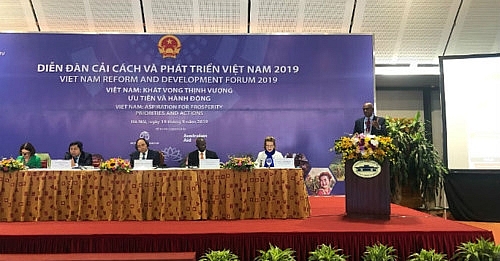Vocational training not to be overshadowed by higher education
 |
| Datuk K. Yogeevaran Kumaraguru, former Secretary-General of the Malaysian Ministry of Plantation Industry and Commodities, presenting why Vietnam needs to focus on both vocational training and higher education to improve labour productivity |
Beginning his talk with a story about Korea's 26 years of upgrading the economy from low to high-income status, Yogeevaran said that Malaysia, despite its rapid growth, is still not where it wants to be as it had forgotten to promote vocational training.
"It took us 27 years to go from low-income to middle-income, and 22 years to go from a middle-income to high-income economy," he said.
The problems of Malaysia, according to K. Yogeevaran, include uneven growth among different regions, unequal distribution, and low labour productivity. Therefore, total factor productivity (TFP) decreases over time. The costs of living also increased, a trend exacerbated by the trade war tensions.
Another problem for Malaysia, Yogeevaran added, is the imbalance in the labour market, where 48 per cent of the workforce is skilled labour, while only 5 per cent of market demand is for skilled workers. This leads to a relatively high unemployment rate among young people who commonly hold university education.
Over the past time, according to the General Statistics Office of Vietnam, labour productivity has been steadily improving and Vietnam is now among the fastest growers in the ASEAN region in this area.
Specifically, the economic growth of 7.08 per cent in 2018 was accompanied by labour productivity of VND102.2 million ($4,443) per worker (in 2018 rates), up 6 per cent on-year. On average in 2016-2018, labour productivity increased by 5.77 per cent per year, higher than the average 4.35 per cent measured in 2011-2015. Generally, in 2011-2018, labour productivity increased by an average of 4.88 per cent per year.
It can be said that labour productivity plays an increasing role in economic growth. In 2011-2015, the average GDP growth reached 5.91 per cent per year, while the workforce grew by 1.5 per cent and labour productivity by 4.35 per cent per year. In 2016 to 2018, although the workforce grew by only 0.88 per cent a year, labour productivity reached an average growth rate of 5.77 per cent, higher than the previous period's 1.42 percentage points, so the average GDP growth rate is 6.7 per cent per year.
Adjusted to 2011 purchasing power parity (PPP 2011), Vietnam's labour productivity in 2011-2018 increased by 4.8 per cent per year on average, higher than many countries in the region, but the gap remains wide and may even increase in absolute terms. This shows that it will be difficult to catch up with other countries.
Relying on Malaysia's experience, Yogeevaran claimed Vietnam shares its problem of productivity. "Productivity issues must be addressed at all three levels, including the national, sectoral, and enterprise levels, in which enterprises must play a leading and important role," Yogeevaran said.
Growth is based on productivity and innovation. Innovation should be oriented to create value and economic benefits. Along with that, a country needs institutional and governance reforms to create a supportive ecosystem and ensure that FDI will bring maximum benefits to the domestic economy.
What the stars mean:
★ Poor ★ ★ Promising ★★★ Good ★★★★ Very good ★★★★★ Exceptional
Related Contents
Latest News
More News
- Ho Chi Minh City hits $8.37 billion in FDI (December 29, 2025 | 08:28)
- Tax sector wraps up 2025 and sets priorities for next year (December 25, 2025 | 14:00)
- Heavy industries set for pilot greenhouse gas quotas (December 25, 2025 | 10:00)
- $250 million deal targets women-owned SMEs, sustainable agriculture (December 22, 2025 | 17:40)
- UOB sees Vietnam growth easing in fourth quarter (December 22, 2025 | 17:39)
- Government moves to establish International Financial Centre (December 21, 2025 | 21:00)
- Vietnam's IFC to target global investment flows (December 21, 2025 | 18:00)
- Ha Tinh breaks ground on major Vingroup industrial and energy projects (December 19, 2025 | 18:24)
- EVN launches major power infrastructure projects nationwide (December 19, 2025 | 18:17)
- VAL inaugurates second production line to meet domestic animal feed demand (December 19, 2025 | 16:37)

 Tag:
Tag:

























 Mobile Version
Mobile Version